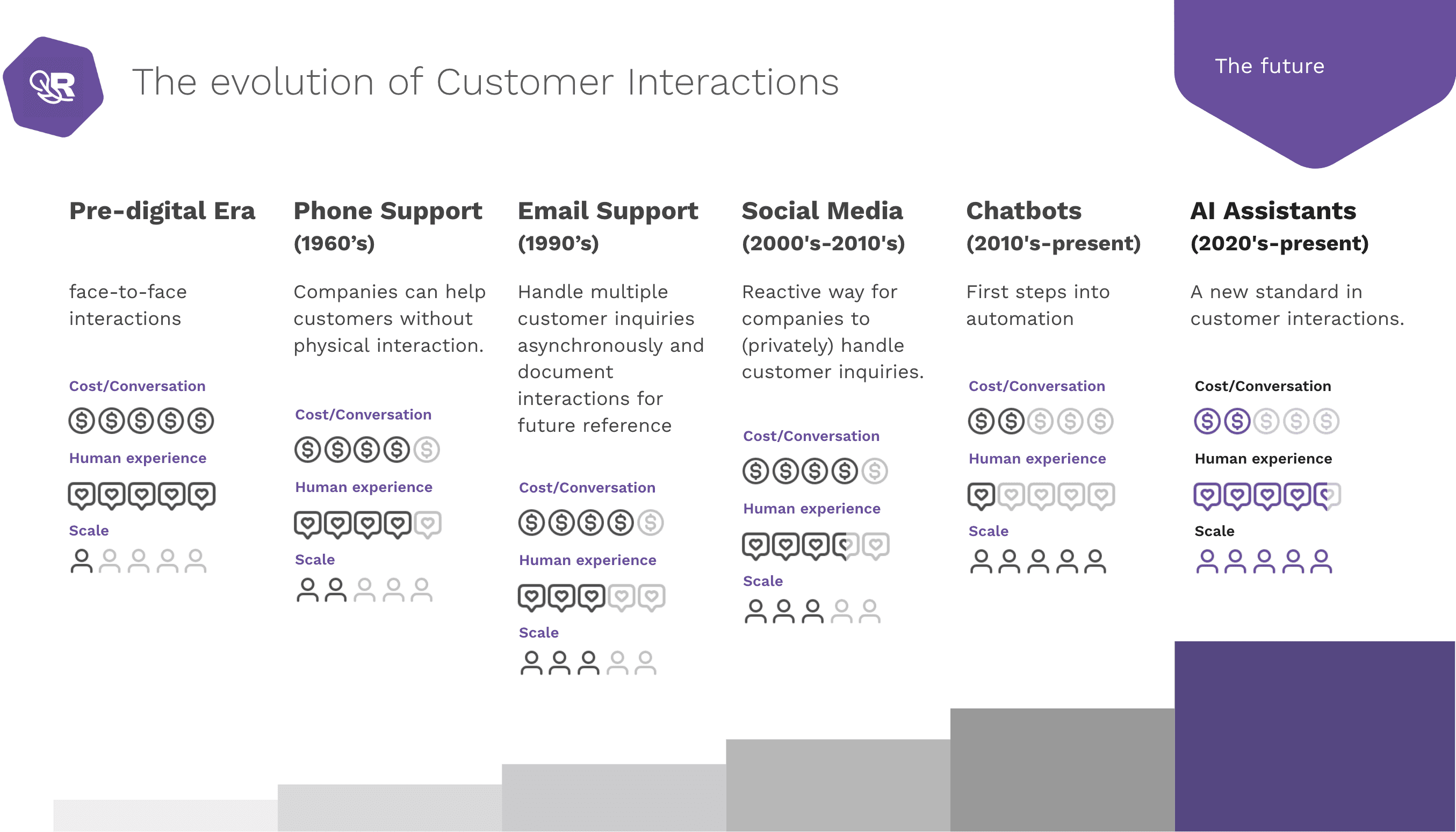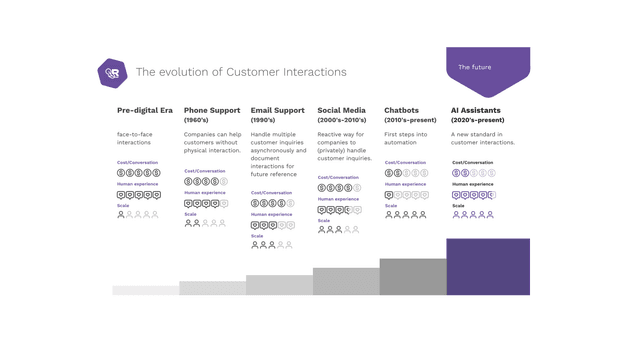
The evolution of Customer Interactions: A journey through time

Reading time: 5m20
The evolution of customer interactions is a reflection of both technological advancements and changing business needs. The journey from face-to-face conversations to AI-driven interactions has been shaped by one key objective: balancing operational efficiency with the need for a personalized, human touch. As businesses have expanded and customer expectations have risen, companies have sought ways to scale their operations without sacrificing the quality of customer engagement. This tension between scalability and personalization is what has driven each significant development in customer service.
The pre-digital era: A human-centered approach
In the pre-digital era, customer service was characterized by face-to-face interactions. During this period, businesses were local, and personal interaction was at its peak. Customers and businesses relied on physical proximity to facilitate their exchanges. The strength of this approach was in its capacity to deliver rich, human-centered communication. Customers could read non-verbal cues such as body language, facial expressions, and tone of voice, while businesses could develop deep, personal relationships with their customers. Trust was built through these direct interactions, creating a strong sense of loyalty and connection.
However, the limitations of face-to-face service were equally clear. Scalability was almost non-existent. Each customer interaction required a significant investment of time and resources, with a one-to-one relationship model dominating the landscape. As businesses grew, it became apparent that this model could not sustain the needs of larger organizations or growing customer bases. The limitations in geographical reach and the labor intensity of face-to-face service meant that businesses could only engage a limited number of customers, often constrained by the physical presence of both parties.
The rise of phone support: A step towards scalability
The introduction of phone support in the 1960s and 1970s marked a pivotal moment in the evolution of customer service. Phone support allowed businesses to extend their reach beyond physical boundaries, enabling them to engage with customers in real-time without requiring a face-to-face meeting. The telephone offered a more scalable solution, as businesses could now manage interactions with customers from different locations and even different time zones.
However, phone support came with its own set of limitations. While it provided immediacy and allowed for real-time problem-solving, it still required a significant amount of human involvement. Customer service representatives were needed to handle each call, which made it difficult to scale operations beyond a certain point. The nature of phone interactions also limited the depth of human engagement compared to face-to-face interactions, non-verbal communication was lost, making it harder to build rapport with customers.
Additionally, as call volumes increased, so did the costs associated with maintaining large customer service teams. This led businesses to explore other options that could help reduce the cost per interaction while still maintaining the ability to engage customers effectively.
The advent of email support: Asynchronous communication at scale
The 1990s saw the emergence of email support, a game-changer in the field of customer service. Email offered businesses the ability to communicate asynchronously with customers, significantly improving efficiency. For the first time, businesses could handle multiple inquiries simultaneously, and customers could reach out without needing to wait on hold or engage in real-time conversations.
Email provided several key benefits: it allowed for documentation of interactions, making it easier to track conversations and resolve disputes, and it introduced a new level of convenience for both businesses and customers. However, email also marked a departure from the real-time, personal nature of previous customer service methods. The lack of immediacy and human connection in email exchanges could sometimes leave customers feeling disconnected, especially in situations where they needed urgent support. While it provided scalability and reduced costs, email did not offer the same personal touch that face-to-face or phone interactions could provide.
Social Media: The birth of public and private, reactive engagement
In the early 2000s, the rise of social media introduced a new paradigm in customer service. Platforms like Twitter, Facebook, and later Instagram and LinkedIn, provided businesses with an opportunity to engage with customers publicly, often in real-time. Social media shifted the focus of customer service from a private exchange to a more visible and reactive model. Customers could now voice their concerns or ask questions on public platforms, and businesses were expected to respond promptly, knowing that other customers were watching.
This visibility introduced both challenges and opportunities. On the one hand, social media allowed companies to demonstrate transparency and accountability in handling customer inquiries. It also provided an avenue for public engagement, which could enhance brand perception. Even after the bulk of conversations on social media began being handled privately via direct messages (DMs), the medium still increased pressure for businesses to respond quickly and efficiently, often requiring dedicated teams to manage these platforms. While it helped reduce costs to some extent, it was still heavily reliant on human agents, and scalability remained limited by the number of interactions a business could handle at any given time.
Chatbots: Automation enters the conversation
The introduction of chatbots in the 2010s represented the first major step towards automation in customer service. Chatbots offered businesses a way to automate responses to common customer inquiries, reducing the need for human agents and enabling 24/7 support. This marked a significant improvement in terms of scalability and cost-effectiveness, as chatbots could handle large volumes of interactions simultaneously without requiring additional resources.
However, the limitations of chatbots quickly became apparent. Their scripted and rigid nature often left customers feeling frustrated, as they were unable to provide meaningful, contextual responses. Chatbots were designed to handle simple, transactional queries but fell short when it came to complex or nuanced customer interactions. As a result, while chatbots improved efficiency and scalability, they did not offer the level of personalization or human-like experience that customers increasingly expected.
The AI Assistant era: A new standard for customer interactions
We now find ourselves at the dawn of the AI assistant era, a significant leap forward in the evolution of customer interactions. Unlike their chatbot predecessors, AI assistants are powered by advanced machine learning algorithms that enable them to process context, adapt their responses, and simulate human-like engagement. While they do not "understand" in the same way humans do, they can recognize patterns in customer behavior and deliver responses that feel more personalized.
The key benefit of AI assistants lies in their ability to provide personalization at scale. By automating repetitive tasks, AI assistants free up human agents to focus on more complex, high-value interactions. At the same time, AI assistants offer 24/7 availability, ensuring that customers can receive support whenever they need it. This combination of efficiency and simulated empathy marks a new standard for customer interactions, where businesses can scale their operations without sacrificing the personal touch.
At Rookoo, we believe that the future of customer service lies in the synergy between human and digital colleagues. Our Digital Employee represents the next evolution of customer interactions, combining the efficiency of automation with the adaptability of human engagement. By enhancing—not replacing—human agents, AI assistants ensure that businesses can scale while maintaining strong, meaningful relationships with their customers.
Conclusion: The road ahead
The evolution of customer interactions has been driven by a constant tension between the need for operational efficiency and the desire to maintain personal, human connections. From face-to-face conversations to AI-driven interactions, each stage of this journey has been marked by both innovation and adaptation to changing business needs.
As we look to the future, the question is not whether AI will play a role in customer service, but how businesses can best leverage AI to enhance their customer interactions. The synergy between human agents and AI assistants offers an exciting opportunity for businesses to scale while delivering personalized, high-quality experiences.